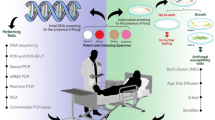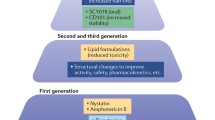Opinion statement
A wide range of immune modulating agents and options for cancer chemotherapeutic agents have led to decreased immunity in human hosts, thereby leading to an increase in the incidence of fungal infections. There has been a parallel increase in the availability of antifungal agents. Antifungal susceptibility testing is important for clinicians to choose or de-escalate to an appropriate antifungal agent and for epidemiological studies. Caution must be used when interpreting susceptibility results as some have not been fully validated for patient care.
Similar content being viewed by others
References and Recommended Reading
Papers of particular interest, published recently, have been highlighted as: • Of importance •• Of major importance
Akan H, Antia VP, Kouba M, Sinko J, Tanase AD, Vrhovac R, et al. Preventing invasive fungal disease in patients with haematological malignancies and the recipients of haematopoietic stem cell transplantation: practical aspects. J Antimicrob Chemother. 2013;68 Suppl 3:iii5–16.
Pagano L, Akova M, DIMOPOULOS G, Herbrecht R, Drgona L, Blijlevens N. Risk assessment and prognostic factors for mould-related diseases in immunocompromised patients. J Antimicrob Chemother. 2011;66 Suppl 1:i5–14.
Pagano L, CAIRA M, Nosari A, van Lint MT, Candoni A, OFFIDANI M, et al. Fungal infections in recipients of hematopoietic stem cell transplants: results of the SEIFEM B-2004 study—Sorveglianza Epidemiologica Infezioni Fungine Nelle Emopatie Maligne. Clinical Infect Dis. 2007;45(9):1161–70.
Cornillet A, Camus C, Nimubona S, Gandemer V, Tattevin P, Belleguic C, et al. Comparison of epidemiological, clinical, and biological features of invasive aspergillosis in neutropenic and nonneutropenic patients: a 6-year survey. Clinical Infect Dis. 2006;43(5):577–84.
Alcazar-Fuoli L, Mellado E. Current status of antifungal resistance and its impact on clinical practice. Br J Haematol. 2014;166(4):471–84.
Miceli MH, Diaz JA, Lee SA. Emerging opportunistic yeast infections. Lancet Infect Dis. 2011;11(2):142–51.
Pfaller MA, Diekema DJ, Gibbs DL, Newell VA, Ellis D, Tullio V, et al. Results from the ARTEMIS DISK Global Antifungal Surveillance Study, 1997 to 2007: a 10.5-year analysis of susceptibilities of Candida species to fluconazole and voriconazole as determined by CLSI standardized disk diffusion. J Clin Microbiol. 2010;48(4):1366–77.
Cormican MG, Pfaller MA. Standardization of antifungal susceptibility testing. J Antimicrob Chemother. 1996;38(4):561–78.
REX JH, Pfaller MA, Rinaldi MG, Polak A, Galgiani JN. Antifungal susceptibility testing. Clin Microbiol Rev. 1993;6(4):367–81.
Pfaller MA, Rex JH, Rinaldi MG. Antifungal susceptibility testing: technical advances and potential clinical applications. Clinical Infect Dis. 1997;24(5):776–84.
Ghannoum MA, Rex JH, Galgiani JN. Susceptibility testing of fungi: current status of correlation of in vitro data with clinical outcome. J Clin Microbiol. 1996;34(3):489–95.
Rex JH, Pfaller MA, Walsh TJ, Chaturvedi V, Espinel-Ingroff A, Ghannoum MA, et al. Antifungal susceptibility testing: practical aspects and current challenges. Clin Microbiol Rev. 2001;14(4):643–58. table of contents.
Subcommittee On Antifungal Susceptibility Testing (Afst) Of The Escmid European Committee For Antimicrobial Susceptibility Testing (Eucast). EUCAST definitive document EDef 7.1: method for the determination of broth dilution MICs of antifungal agents for fermentative yeasts. Clin Microbiol Infect. 2008;14(4):398–405. http://www.eucast.org/fileadmin/src/media/PDFs/EUCAST_files/AFST/EUCAST_EDef_7_2_revision.pdf.
Kanafani ZA, Perfect JR. Antimicrobial resistance: resistance to antifungal agents: mechanisms and clinical impact. Clinical Infect Dis. 2008;46(1):120–8.
Van Der Linden JW, Jansen RR, Bresters D, Visser CE, Geerlings SE, Kuijper EJ, et al. Azole-resistant central nervous system aspergillosis. Clinical Infect Dis. 2009;48(8):1111–3.
Pappas PG, Kauffman CA, Andes D, Benjamin Jr DK, Calandra TF, Edwards Jr JE, et al. Clinical practice guidelines for the management of candidiasis: 2009 update by the Infectious Diseases Society of America. Clinical Infect Dis. 2009;48(5):503–35.
Rex JH, Pfaller MA. Has antifungal susceptibility testing come of age? Clinical Infect Dis. 2002;35(8):982–9.
Spellberg BJ, Filler SG, Edwards Jr JE. Current treatment strategies for disseminated candidiasis. Clinical Infect Dis. 2006;42(2):244–51.
Pfaller MA, Yu WL. Antifungal susceptibility testing. New technology and clinical applications. Infect Dis Clin N Am. 2001;15(4):1227–61.
Balajee SA, Houbraken J, Verweij PE, Hong SB, Yaghuchi T, Varga J, et al. Aspergillus species identification in the clinical setting. Stud Mycol. 2007;59:39–46.
Posteraro B, Sanguinetti M. The future of fungal susceptibility testing. Future Microbiol. 2014;9(8):947–67.
Posteraro B, Torelli R, De Carolis E, Posteraro P, Sanguinetti M. Antifungal susceptibility testing: current role from the clinical laboratory perspective. Mediterr J Hematol Infect Dis. 2014;6(1), e2014030.
Pfaller MA, Diekema DJ. Progress in antifungal susceptibility testing of Candida spp. by use of Clinical and Laboratory Standards Institute broth microdilution methods, 2010 to 2012. J Clin Microbiol. 2012;50(9):2846–56.
Pfaller MA. Antifungal drug resistance: mechanisms, epidemiology, and consequences for treatment. Am J Med. 2012;125(1 Suppl):S3–13.
Arthington-Skaggs BA, Warnock DW, Morrison CJ. Quantitation of Candida albicans ergosterol content improves the correlation between in vitro antifungal susceptibility test results and in vivo outcome after fluconazole treatment in a murine model of invasive candidiasis. Antimicrob Agents Chemother. 2000;44(8):2081–5.
Marr KA, Rustad TR, Rex JH, White TC. The trailing end point phenotype in antifungal susceptibility testing is pH dependent. Antimicrob Agents Chemother. 1999;43(6):1383–6.
Posteraro B, Torelli R, De Carolis E, Posteraro P, Sanguinetti M. Antifungal susceptibility testing: current role from the clinical laboratory perspective. Mediterr J Hematol Infect Dis. 2014;6(1), e2014030.
Espinel-Ingroff A, Cuenca-Estrella M, Cantãn E. EUCAST and CLSI: working together towards a harmonized method for antifungal susceptibility testing. Current FungalInfection Reports. 2013;7(1):59–67. Reference detailing CLSI and EUCAST methods and breakpoints.
Pfaller MA, Andes D, Arendrup MC, Diekema DJ, Espinel-Ingroff A, Alexander BD, et al. Clinical breakpoints for voriconazole and Candida spp. revisited: review of microbiologic, molecular, pharmacodynamic, and clinical data as they pertain to the development of species-specific interpretive criteria. Diagn Microbiol Infect Dis. 2011;70(3):330–43.
Arendrup MC, Perlin DS. Echinocandin resistance: an emerging clinical problem? Curr Opin Infect Dis. 2014;27(6):484–92. Recent reference detailing echinocandin resistance.
Perlin DS. Echinocandin resistance, susceptibility testing and prophylaxis: implications for patient management. Drugs. 2014;74(14):1573–85.
Shah DN, Yau R, Weston J, Lasco TM, Salazar M, Palmer HR, et al. Evaluation of antifungal therapy in patients with candidaemia based on susceptibility testing results: implications for antimicrobial stewardship programmes. J Antimicrob Chemother. 2011;66(9):2146–51.
Pfaller MA, Diekema DJ, Andes D, Arendrup MC, Brown SD, Lockhart SR, et al. Clinical breakpoints for the echinocandins and Candida revisited: integration of molecular, clinical, and microbiological data to arrive at species-specific interpretive criteria. Drug Resist Updat. 2011;14(3):164–76.
Park BJ, Arthington-Skaggs BA, Hajjeh RA, Iqbal N, Ciblak MA, Lee-Yang W, et al. Evaluation of amphotericin B interpretive breakpoints for Candida bloodstream isolates by correlation with therapeutic outcome. Antimicrob Agents Chemother. 2006;50(4):1287–92.
Perfect JR, Cox GM, Lee JY, Kauffman CA, De Repentigny L, Chapman SW, et al. The impact of culture isolation of Aspergillus species: a hospital-based survey of aspergillosis. Clinical Infect Dis. 2001;33(11):1824–33.
Walsh TJ, Anaissie EJ, Denning DW, Herbrecht R, Kontoyiannis DP, Marr KA, et al. Treatment of Aspergillosis: clinical practice guidelines of the infectious diseases society of America. Clinical Infect Dis. 2008;46(3):327–60.
Walsh TJ, Anaissie EJ, Denning DW, Herbrecht R, KONTOYIANNIS DP, Marr KA, et al. Treatment of Aspergillosis: clinical practice guidelines of the Infectious Diseases Society of America. Clinical Infect Dis. 2008;46(3):327–60.
Denning DW, Venkateswarlu K, Oakley KL, Anderson MJ, Manning NJ, Stevens DA, et al. Itraconazole resistance in Aspergillus fumigatus. Antimicrob Agents Chemother. 1997;41(6):1364–8.
Howard SJ, Cerar D, Anderson MJ, Albarrag A, Fisher MC, Pasqualotto AC, et al. Frequency and evolution of Azole resistance in Aspergillus fumigatus associated with treatment failure. Emerg Infect Dis. 2009;15(7):1068–76.
Marr KA, Schlamm HT, Herbrecht R, Rottinghaus ST, Bow EJ, Cornely OA, et al. Combination antifungal therapy for invasive aspergillosis: a randomized trial. Ann Intern Med. 2015;162(2):81–9.
Kurtz MB, Heath IB, Marrinan J, Dreikorn S, Onishi J, Douglas C. Morphological effects of lipopeptides against Aspergillus fumigatus correlate with activities against (1,3)-beta-D-glucan synthase. Antimicrob Agents Chemother. 1994;38(7):1480–9.
Espinel-Ingroff A, Cuenca-Estrella M, Fothergill A, Fuller J, Ghannoum M, Johnson E, et al. Wild-type MIC distributions and epidemiological cutoff values for amphotericin B and Aspergillus spp. for the CLSI broth microdilution method (M38-A2 document). Antimicrob Agents Chemother. 2011;55(11):5150–4.
Gupta P, Khare V, Kumar D, Ahmad A, Banerjee G, Singh M. Comparative evaluation of disc diffusion and E-test with broth micro-dilution in susceptibility testing of amphotericin B, voriconazole and caspofungin against clinical aspergillus isolates. J Clin Diag Res. 2015;9(1):DC04–7.
CANTON E, Espinel-Ingroff A, Peman J. Trends in antifungal susceptibility testing using CLSI reference and commercial methods. Expert Rev Anti-Infect Ther. 2009;7(1):107–19.
Alexander BD, Byrne TC, Smith KL, Hanson KE, Anstrom KJ, Perfect JR, et al. Comparative evaluation of Etest and sensititre yeastone panels against the Clinical and Laboratory Standards Institute M27-A2 reference broth microdilution method for testing Candida susceptibility to seven antifungal agents. J Clin Microbiol. 2007;45(3):698–706.
Wanger A, Mills K, Nelson PW, Rex JH. Comparison of etest and national committee for clinical laboratory standards broth macrodilution method for antifungal susceptibility testing: enhanced ability to detect amphotericin B-resistant Candida isolates. Antimicrob Agents Chemother. 1995;39(11):2520–2.
Arikan S, Sancak B, Alp S, Hascelik G, Mcnicholas p. Comparative in vitro activities of posaconazole, voriconazole, itraconazole, and amphotericin B against Aspergillus and Rhizopus, and synergy testing for Rhizopus. Med Mycol. 2008;46(6):567–73.
Johnson MD, Macdougall C, Ostrosky-Zeichner L, Perfect JR, Rex JH. Combination antifungal therapy. Antimicrob Agents Chemother. 2004;48(3):693–715.
Pfaller MA, Diekema DJ. Epidemiology of invasive candidiasis: a persistent public health problem. Clin Microbiol Rev. 2007;20(1):133–63.
Perlin DS. Antifungal drug resistance: do molecular methods provide a way forward? Curr Opin Infect Dis. 2009;22(6):568–73.
Rex JH, Pfaller MA, Walsh TJ, Chaturvedi V, Espinel-Ingroff A, Ghannoum MA, et al. Antifungal susceptibility testing: practical aspects and current challenges. Clin Microbiol Rev. 2001;14(4):643–58. table of contents.
Compliance with ethics guidelines
Conflict of interest
Luis Ostrosky-Zeichner reports grants and personal fees from Merck, grants and personal fees from Astellas, grants and personal fees from Pfizer, outside the submitted work, and Ostrosky-Zeichner has served a voting member and is currently a reviewer for the CLSI Antifungal Susceptibility Testing Subcommittee. Ostrosky-Zeichner has served a voting member and is currently a reviewer for the CLSI Antifungal Susceptibility Testing Subcommittee. Nagakrishnal Nachimuthu has no disclosures relevant to this work.
Human and animal rights and informed consent
This article does not contain any studies with human or animal subjects performed by the author.
Author information
Authors and Affiliations
Corresponding author
Additional information
This article is part of the Topical Collection on Fungal Infections
Rights and permissions
About this article
Cite this article
Nachimuthu, N., Ostrosky-Zeichner, L. Antifungal Susceptibility Testing: Evolution, Indications, and Role in Clinical Practice. Curr Treat Options Infect Dis 7, 155–162 (2015). https://doi.org/10.1007/s40506-015-0056-2
Published:
Issue Date:
DOI: https://doi.org/10.1007/s40506-015-0056-2




